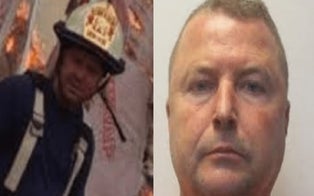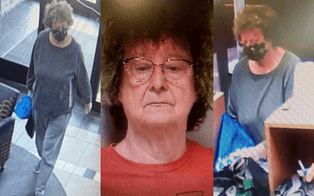Investigative journalist Maureen Callahan's "American Predator" offers an unrivaled look at the investigation into Israel Keyes and the killings he is believed to have committed.
From the outside, the life Israel Keyes built in Anchorage, Alaska, was simple and straightforward.
He was a doting father. He was reliable handyman whose skill allowed for a career as a contractor.
He was in a long-term relationship with a woman with whom he had made a home.
But those who thought they knew Keyes would have their notions upended when he was arrested for the kidnapping of Samantha Koenig in 2012. The 18-year-old high school senior’s abduction at a month earlier from the coffee kiosk where she worked left Keyes’ own community reeling, as investigators scrambled — in vain, they would later learn — to find her alive.
Theirs was “a race against time,” and one that “would lead the FBI to the most unprecedented serial killer they had ever encountered,” investigative journalist Maureen Callahan told InsideEdition.com.
Callahan traces Keyes’ yearslong reign of terror, the investigation that led to his capture and the lingering mysteries surrounding the case in the New York Times best-seller “American Predator: The Hunt for the Most Meticulous Serial Killer of the 21st Century.”
The true crime book is result of years Callahan spent researching, conducting interviews and fighting in court for access to government files that provided more insight into perhaps one of the worst serial killers in the U.S.’s history.
“I knew that there would be even more mysteries to uncover. I could never have predicted what I encountered,” she said. “Just when you think he thought of it all, then something else comes out of his mouth and you're like, holy s***.”
+++
Told with the perspective of law enforcement ever in mind, Callahan’s narrative begins with the killing that proved to be Keyes’ undoing.
Samantha Koenig’s disappearance after her shift at a coffee kiosk in Anchorage on Feb. 1, 2012 at first left some law enforcement stumped. The register was empty, the shack had been locked and security camera video showed the teen leaving with an unknown adult male.
But closer examination of the footage showed how afraid Koenig was and that she had been ordered to put her hands up and kneel on the ground as her abductor deftly dove into the kiosk and forced her out. Additional footage showed her attempt to escape, but the suspect, who could only be described as ““tall and athletic,” quickly subdued her once again, forced her into a truck and drove off into the night.
Loved ones received a glimmer of hope when investigators discovered a ransom note demanding $30,000 be deposited into Koenig’s bank account. The note included a photo that appeared to show Koenig alive, and when someone began making withdrawals from Koenig’s account, police had the lead they needed.
“It’s pinging in the lower 48, in New Mexico, and so the agents in Anchorage rushed [to] the office, and they're watching this in real time,” Callahan said. “They're watching him move on the interstate and they're rousting field agents and local law enforcement out of bed and small bank owners, because he's trying to use his ATM at really small banks.”
Police tracked the suspect to Texas, where Texas Ranger Steve Rayburn took it upon himself to make sure his men took seriously the search for a kidnapper only known to be a white, middle-age man driving a Ford Focus.
“He gets a phone call from a ranger whose about to go off duty who says, ‘I'm driving by this hotel, I see this car, I see a guy up on that balcony, he's a white male,’” Callahan said. “And one of the weirdest slow police chases ensues, until they pull this guy over on the side of a road, right before he's about to get on route with no speed limit of any magnitude, with no traffic lights. And the ranger says, ‘Can I see your driver’s license, and where are you from?’ And the man says, ‘Alaska.’”
+++
Koenig wouldn’t be seen alive again. She wasn’t alive in the photo authorities would go on to learn Keyes had spent hours staging, and weeks after she disappeared, Koenig’s dismembered body and the weights intended to conceal it forever would be pulled from the bottom of Matanuska Lake in Alaska.
But that was just the tip of the iceberg when it came to Keyes, investigators quickly learned.
“Israel Keyes was one of the most terrifying subjects the FBI had ever encountered,” Callahan said. “He was the serial killer that confounded the Bureau's Top Criminal Profilers, and he had an unprecedented MO that included killing all over the United States with zero victim profile, and devising a mode of travel that rendered him undetectable.”
Keyes traveled frequently and in no discernible pattern. He often bought one-way plane tickets that left him in major hubs, would then rent a car and drive hundreds of miles to retrieve one of his stashed “kill kits,” or cash, weapons and cleaning supplies he buried in a five-gallon Home Depot bucket well in advance.
“He would then hunt around looking for victims,” Callahan said. “He had no preference. He would go after young, old, women, men, white, black, alone, in pairs. It did not matter.”
As strong as he was stealthy, Keyes was able to abduct his victims within seconds.
“He would take them to another location where he would torture, rape them and kill them,” Callahan said. “He would then take the bodies to yet another location, preferably crossing state lines, dispose of the remains so expertly that he left no DNA behind. And then very quickly put hundreds, if not thousands, of miles again between him and that crime scene so that there was no way to link him to anything.”
He did all of this after removing the battery from his phone so as to further remove any possibility of detection.
“I call Israel Keyes a ‘cluster bomb,’” Callahan said. “He took, and this sounds weird to say, but the best practices from serial killers who came before him. He was a real student of it.”
+++
Keyes studied the methods of infamous predators as well as the men and women who caught them, reading books the FBI’s top profilers wrote on their years of experience hunting monsters. He also drew from pop culture.
“He learned from 'CSI.' … He learned from 'Criminal Minds' how the bureau thinks. So he devised this way of being sure not to leave any DNA behind,” Callahan said.
His acquired knowledge was coupled with a unique upbringing and skills learned because of it. One of 10 children in a family brought up by survivalist parents, Keyes spent his early years living off the land and honing his skills as a hunter.
“His parents pull the family up to a very remote area of Washington state when he's very young, when he's 4, to Colville, Washington, where the father spends seven years building them a cabin to live in. In the meantime, the children are living in tents,” Callahan said. “They have to hunt their own food so they can eat. So, you're building a child who's learning how to do all of this stuff while inculcating them with, ‘Don't trust the federal government.’”
But Keyes went on to become part of the federal government himself when in 1998, he joined the U.S. Army.
“From what men who served with him told the FBI, it was very clear that he was a super soldier and that the feats that he could physically perform were astonishing to them," Callahan said.
Investigators would come to learn all of this and more as they sought to glean more information from Keyes himself, but it wasn’t without struggle. Though he eventually admitted to killing Koenig and directed authorities to fher body, getting Keyes to divulge further information was extremely difficult.
His key motivators appeared to be keeping his name out of the media to save his daughter the anguish of having to read about her father, as well as the desire to expedite proceedings so that he could be executed for his crimes.
That motivator led authorities to the next leg of their investigation.
+++
“FBI agents are telling Israel Keyes that if he wants the death penalty, they need more victims, and he says, after a pause, ‘OK. I'll give you two bodies. I'll give you two bodies and a name,’" Callahan said.
Bill and Lorraine Currier, 50 and 55, went missing from their home in Essex, Vermont, in June 2011.
Though their car, suitcases and some clothing and jewelry were also gone, those who knew the couple immediately believed something to be wrong, and police who responded to the home found medicine both needed every day left behind.
“The responding lieutenant on the scene told the media, ‘It's a real puzzler,’” Callahan said of the case, which quickly went cold. “There was no real evidence of any kind to explain where they were or why they had left. There was no activity in the coming weeks and months on their cellphones, or their bank cards, or their credit cards.”
Keyes was responsible for the torture they endured and their eventual killings, which he told investigators he carried out at an abandoned house.
“[The FBI asked Keyes], ‘Well, had you known them?’ And he says, ‘Nope.’ And they say, ‘Had you met them before?’ And he says, ‘Nope.’ And they say, ‘Well, how? Why?’” Callahan said. “And he said, ‘I knew how to break in.’”
+++
Officials say they believe Keyes to be responsible for 11 murders.
Of those 11, the Curriers, Koenig and a woman named Debra Feldman, whose body was recovered in New York, are the only victims of Keyes whose names are known.
Others, including Callahan, believe the number of people Keyes killed to be far higher than 11.
After cross-referencing the many photos of known missing persons found on Keyes’ computer, the timeline of his movements investigators were able to establish and tips made to the FBI from citizens who believe their loved ones may have been among Keyes’ victims, Callahan said she was able to identify 44 persons who may have been killed by Keyes.
Concretely proving or disproving their connection to Keyes, however, may prove more challenging.
In December 2012, Keyes was found dead in his jail cell. He had taken his own life, officials said.
“How many people Israel Keyes actually took and killed, I think, will always be a mystery,” Callahan said.
But it’s Callahan’s hope that her book will help spur further investigation into the cases that could potentially be tied to Keyes, as well as lead to more answers she says authorities have.
“At a certain point late in the investigation the FBI reclassifies this case and it goes from serial murder to terrorism. They've never made that public,” she said. “He sat for a six-and-a-half-hour court-ordered evaluation with a forensic psychologist. That was a six-and-a-half-hour taped interview. Why can't we hear it? Why is so little known about the night that Keyes killed himself?
“There is no argument that is within the public interest to know exactly what Keyes was doing, what the FBI knows about what Keyes was doing, and what the Department of Justice, or the U.S. military knows about how Keyes was trained, what he was doing, why his case was designated as terrorism,” she continued. “We all have a right to know it.
"This isn't just a horror story, or a cold case here and there. I think it’s a lot bigger than that.”
The FBI declined InsideEdition.com's request for comment.
RELATED STORIES





